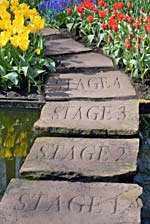| Transition to CM, Stage 4:
Add In  The past three weeks we have been discussing some ideas for easing into the Charlotte Mason Method in your home school. Remember to take your time and get comfortable with each step and each stage before you move on to the next. This is not a race. It involves many new decisions and new ways of thinking. So don't get in a hurry or feel like you're "behind"; you'll do just fine. The past three weeks we have been discussing some ideas for easing into the Charlotte Mason Method in your home school. Remember to take your time and get comfortable with each step and each stage before you move on to the next. This is not a race. It involves many new decisions and new ways of thinking. So don't get in a hurry or feel like you're "behind"; you'll do just fine.
Today we'll talk about adding in a few more methods to polish off and finish up your transition. Here are some ideas for adding geography, foreign language, Shakespeare, and recitation into your Charlotte Mason education. Geography Just like you are using living books for history, you can use living books for geography. Look for interesting travelogues, or simply keep a globe nearby. Anytime you read a living book, go to the globe and find where the events took place. Just as history is the story of people and what happened to them, geography is where those events happened to those people. The closer you can tie geography to people, the more living it will become. You can also take just five or ten minutes per week to study a region, country, or continent on a map. That may not seem like much, but those few minutes done faithfully every week add up to a solid familiarity with that part of the map. Use a blank outline map and have the students label some of it each week, or challenge them to draw the area and label it. You can read more on our site if you would like the details of how our family does map drill. Foreign Language Don't panic if you haven't planned to incorporate a foreign language. That's fine. You may want to wait until you have access to the resources you need. Or you may want to wait until you know whether foreign language credits are required by any laws in your region. The information in this section will give you some ideas if and when you want to add foreign language. (And if this section is stressing you out, skip it.) Charlotte believed that we should teach a foreign language in the same way as our native language: hear and speak it first, then read and write it. Just as babies learn to hear and speak English (or whatever your native language is) first, so we should start learning a different language by hearing and speaking it. Reading and writing can come later. If you use the hear-and-speak-it-first approach, children can start learning a foreign language at an early age. Try to make the lessons practical and living from the start: names of objects in their environment, simple stories about those objects, songs and games in that language. The ideal resource for teaching a foreign language is a person who speaks it natively. Invite that person into your home once or twice a week to play games with and talk with your child. If you don't have access to such a person, look for a curriculum that approaches the language in the way we described in this section. Shakespeare An easy way to do Shakespeare is to follow this three-step plan: -
Read the play in story form to get a good feel for the plot and characters. Two books especially are our favorites for this step: Tales from Shakespeare by Charles and Mary Lamb and Beautiful Stories from Shakespeare for Children by E. Nesbit. -
Read through part or all of the play in its original language. If possible, assign different roles to your children to try their hand at reading aloud. -
Watch a presentation of the play, either live or recorded. As with any material that you give your children, please use discretion and wisdom in selecting which Shakespeare plays you want to use and previewing the presentations you will show them. If you would like some suggestions of plays to start with, take a look at the Shakespeare page of our free SCM Curriculum Guide. Recitation Recitation is a great tool to add into your Charlotte Mason education. Encouraging your child to memorize and then recite gives her a wonderful mental storehouse of good and noble thoughts. Recitation is also great preparation for public speaking. Assign a variety of poetry and Scripture for your child to memorize and recite. Coach her to present beautiful words in a beautiful way. Look for opportunities for your child to recite: hold a poetry recital and invite everyone to prepare a poem to present; record your child reciting and send the recording to relatives; give a poetry and Scripture program at a local assisted living center or nursing home. While we're on the subject of Scripture memory, our family has loved this simple Scripture Memory System. It helps us continue to memorize new verses, passages, and chapters throughout the year, but it also guides us every month to review every verse we have memorized. And it takes just 5–10 minutes a day. Take a look. Well, those are our suggestions for making the transition to the Charlotte Mason Method step by step. We hope these four stages have made the transition look do-able to you. We would love to hear from some of you experienced CMers. What comments or practical tips would you give to those who want to make the transition to Charlotte Mason? Leave a comment and let us know. | 






Aucun commentaire:
Publier un commentaire
Merci pour vos commentaires :-)